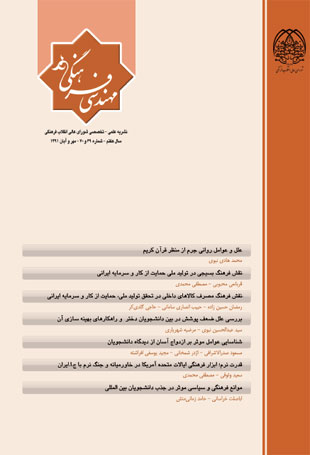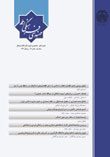فهرست مطالب

فصلنامه مهندسی فرهنگی
پیاپی 69-70 (مهر و آبان 1391)
- تاریخ انتشار: 1391/09/01
- تعداد عناوین: 7
-
Page 10In every society, security is the most essential factor to ensure sustainable growth and development, while crime is the most important adversary of social security with which it has a negative relation. During recent years, the rise of changes in traditional models has increased the risk of people’s engagement in criminal acts, especially among the youth. The rise of criminal behaviors has made governments try to find solutions. Criminalization is the first reaction, while enacting criminal laws should be the last resort, rather than the first, in fighting against crime. Unsuitable criminalization is not only an ineffective solution, but it also engenders new deviances. That is why prevention of crime receives much more attention today as one of the most important measures to be taken against crime, and it constitutes a major portion of ‘crime fighting’ literature in our time. In order to prevent a crime, it is necessary to consider its causes. The present paper tries to illustrate the mental causes of crime from a Quranic point of view; hence it has identified twelve mental factors leading to crime and sin, including envy and arrogance.Keywords: metal factors, crime, Holy Quran, sin, prevention
-
Page 25The basijiculture is a symbol of the behavior of basijis aimed at protecting the religious, Islamic values in society. The values governing an Islamic society are the fruit of all the efforts and sacrifices made by devotees, especially basijis, in social and defensive arenas. At the present time, when Western economic sanctions against Iran have expanded, at his New Year’s message in March 2012, Ayatollah Khamenei, the supreme leader of the Islamic Republic of Iran, asserted that economic struggle and jihad-like presence of the Iranian nation in economic arenas are necessary; he pointed out that “an important part of economic jihad is the ‘domestic production’, and if the nation can resolve the domestic production problem through endeavor, determination, and awareness accompanied by officials’ appropriate planning, then it no doubt will be able to overcome the challenges posed by the enemy”. Inviting all the economic officials as well as each one of the people to move toward enhancing the domestic production, Ayatollah Khamenei declared “domestic production and supporting the Iranian work and capital” as the motto of the Iranian year 1391 (2012–2013). The present study tries to examine the role of basiji culture in supporting the domestic production and Iranian work and capital along with the leader’s orders. The results indicate that the rule of basiji culture can promote a culture of working and struggling regardless of deficiencies and limitations, support domestic production, and,to some extent, thwart the Western sanctions.Keywords: culture, basiji forces, basiji culture, domestic production, supporting he Iranian work, capital, the supreme leader
-
Page 63The issue of hijab has not and is not an issue specific to a certain community or a geographical stretch of the world;rather, it is a universal issue embedded in various communities and their historical evolution. Protection of the Islamic values and rituals is a duty of all institutions and individuals, the observance of Islamic coverage (hijab) being an obvious instance of the same. Therefore, resorting to new and updated strategies in attracting the students to religious gatherings, the cultural departments of universities should try all the more to reconsider and present various rational aspects of the necessity of paying attention to hijab; furthermore, introducing exemplary women in Islam and Iran and expressing how they have been influential in the history and developments of the society, especially regarding to hijab, can be helpful in improving the status of hijab among female students. This article has tried to address this issue from a general perspective and with a rather sociological approach, analyzing factors which lead to this poor status of hijab among female students. Finally, a set of policies and strategies have been proposed the exact implementation of which along with other potential solutions may hinder the increasing growth of this problem. Although library method has been used in this study, it has been attempted that relevant field studies be applied as well.Keywords: coverage model, student, lack of hijab, optimization, promotion, theoretical, practical levels
-
Page 86The present paper tries to identify the factors influencing easy marriage from the point of view of university students. The descriptive survey method has been used in this study, with questionnaire as its data collection tool. The statistical population of this research comprises female students of Payam-e Noor University in Razan County, Iran, who were studying in the first semester of the academic year 2011–2012. Through simple random sampling, 100 students were selected, and then they filled out the questionnaires. In order to analyze the data, the SPSS software program was used; the data were then analyzed through descriptive statistical indices (e.g. frequency, percentage, etc.) and inferential indices (e.g. Chi-square test).
-
Page 102This paper aims to examine the US soft power in the Middle East and analyze the US soft confrontation with Iran through the theoretical framework proposed by Josef Nye. Global and regional powers have always tried to control the management of the global and regional developments in order to sustain and increase their own power. As a geopolitical and geostrategic region, the Middle East has a special significance in the global equations to the extent that this region’s developments have attracted the attention of major powers, including the US, as a hegemon on the global system, and Iran, as a regional, anti-hegemony power. Using its soft power in the Middle East, the US tries to confront with Iran at a regional leveland weaken its power. Based on this introduction, the current paper tries to examine soft power as a cultural tool for the US in this region and how this country uses this tool to confront with the Islamic Republic of Iran.Keywords: soft power, soft war, the United States of America, the Islamic republic of Iran, Middle East, culture, general diplomacy
-
Page 126The resent paper tries to examine the cultural and political obstacles preventing the enrollment of international university students. The research method has been applied (in terms of purpose) and descriptive-survey (in terms of data collection method). The statistical population comprises all faculty members (N=575) and international students (N=75) at Shahid Beheshti University; from among these, 234 faculty members were selected through proportional stratified sampling method, and 63 international students were selected via simple random sampling. The research tool was a researcher-made questionnaire whose reliability and validity has been verified. The most significant findings of this study indicate that, from the faculty members’ pointof view, the highest average among cultural obstacles belonged to “inefficiency in motivating and interesting social/cultural space (0.7944.08±)” while the same among political obstacles belonged to “the closed doors of higher education to implementation of new ideas (0.7954.23±)”; form international students’ point of view, the highest averages among cultural obstacles belonged to “holding pessimistic views towards the presence of international students (1.053.84±)” and the same among political obstacles belonged to “the limited familiarity of other nations with Iranian/Islamic culture and civilization (0.7554.09±)”.Keywords: higher education, cultural obstacles, political obstacles, international students


